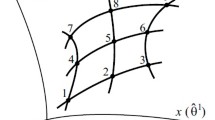The mixed projection-mesh scheme of the finite element method was used to set a mixed approximation for three finite elements in the form of a hexagonal eight-node prism with the substitution of displacements after the polylinear law and stress and strain approximation with polynomial interpolation functions, defined for the nodes at the vertices, in the prism center, in the face centers, inner points, and a tetrahedron-shaped element in which displacements are sought in the nodes at the vertices, and stresses and strains are in the nodes at the vertices and in the center. The expressions for the coefficients of the decision matrices are obtained. Several test problems with analytical or known numerical solutions in the elastic statement are examined. The results obtained with the mixed method were compared with those obtained from the finite element method. The relative errors in determining examined characteristics were assessed in the elastic statement. The Irwin plastic zone correction was evaluated in the elastoplastic statement. One of the proposed elements would be appropriate for further application from the solution results and the estimation of time taken for solving specific problems and data body processing.









Similar content being viewed by others
References
O. C. Zienkiewicz, The Finite Element Method in Engineering Science, McGraw-Hill (1971).
R. H. Gallagher, Finite Element Analysis: Fundamentals, Englewood Cliffs, USA (1975).
P. P. Voroshko, “Combined variational formulations for problems of the theory of elasticity and their realization by the finite-element method,” Strength Mater, 17, No. 1, 123-130 (1985). https://doi.org/10.1007/BF01532794
S. É. Umanskii, “General theory and practical application of softly mixed schemes of the finite-element method,” Strength Mater, 16, No. 12, 1746–1754 (1984). https://doi.org/10.1007/BF01538012
A. S. Sakharov, “The moment scheme of finite elements (FEM) with account of rigid displacements,” in: Strength of Materials and Theory of Structures [in Russian], Issue 24, Kiev (1974), pp. 147-156.
S. N. Atluri, R. H. Gallagher, and O. C. Zienkiewicz, Hybrid, and Mixed Finite Element Methods, Wiley, Chichester (1983).
I. Babuska, J. T. Oden, and J. K. Lee, Mixed-Hybrid Finite Element Approximations of the Second-Order Elliptic Boundary-Value Problems, TICOM Report 75-7, University of Texas at Austin, Austin (1971).
P. G. Bergan and M. K. Nygard, “Finite elements with increased freedom in choosing shape functions,” Int J Num Meth Eng, 20, 643–664 (1984).
A. Yu. Chirkov, Mixed Scheme of the Finite Element Method for Solving Boundary Value Problems of the Theory of Elasticity and Small Elastoplastic Strains [in Russian], Pisarenko Institute of Problems of Strength of the National Academy of Sciences of Ukraine, Kyiv (2003).
V. V. Kharchenko, A. Yu. Chirkov, S. V. Kobelskii, and V. I. Kravchenko, Methods of Computational Analysis in the Problems of Strength of WWER Equipment Elements [in Russian], Pisarenko Institute of Problems of Strength of the National Academy of Sciences of Ukraine, Kyiv (2018).
I. P. Mysovskikh, Interpolation Cubature Formulas [in Russian], Nauka, Moscow (1981).
S. N. Atluri (Ed.), Computational Methods in the Mechanics of Fracture, Elsevier Science Ltd, Amsterdam (1986).
E. F. Rybicki and M. F. Kanninen, “A finite element calculation of stress intensity factors by a modified crack closure integral,” Eng Fract Mech, 9, No. 4, 931-938 (1977).
M. P. Savruk, Stress Intensity Factors in Cracked Bodies [in Russian], Naukova Dumka, Kiev (1988).
G. R. Irwin, “Relation of crack toughness measurements to practical applications,” Welding J Res Suppl, 41, 519–528 (1962).
A. I. Lurie, Spatial Problems of the Theory of Elasticity [in Russian], State Publishing House of Technical and Theoretical Literature, Moscow (1955).
Y. Murakami (Ed.), Stress Intensity Factors Handbook, Pergamon Press, Oxford (1987).
Author information
Authors and Affiliations
Corresponding author
Additional information
Translated from Problemy Mitsnosti, No. 1, pp. 83 – 97, January – February, 2024.
Rights and permissions
Springer Nature or its licensor (e.g. a society or other partner) holds exclusive rights to this article under a publishing agreement with the author(s) or other rightsholder(s); author self-archiving of the accepted manuscript version of this article is solely governed by the terms of such publishing agreement and applicable law.
About this article
Cite this article
Kobelskyi, S.V. Modification of the Mixed Finite Element Method for Solving Boundary Problems of Mechanics of Deformable Structures in the Three-Dimensional Statement: Basic Principles and Test Problems. Strength Mater 56, 70–82 (2024). https://doi.org/10.1007/s11223-024-00628-6
Received:
Published:
Issue Date:
DOI: https://doi.org/10.1007/s11223-024-00628-6




